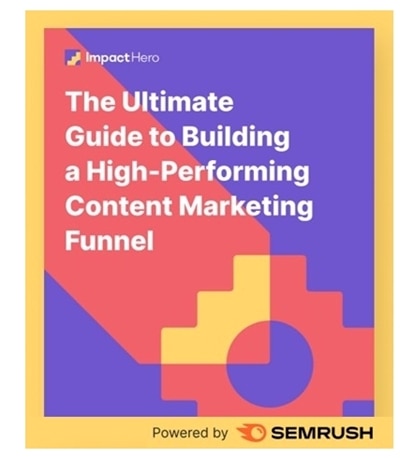Most of the content we interact with online is intended to make us take an action, such as following a link, upvoting a post, downloading a study, signing up for a trial, etc.
However, those who interact with marketing content are not always too eager to respond on a whim; therefore, it's key to treat conversion as a part of a larger customer journey and create our content marketing touchpoints accordingly.
To guide the potential customer in the right direction, you need a well-thought-out content marketing funnel in which each piece of content plays its allotted part.
Semrush has done a great deal of research to find out how content marketers build their funnels in 2021, what content formats they use, and what challenges they face. Below, you'll find insights from our recent studies and webinars.
If you read the article to the end, you'll get a bonus resource that will let you analyze and improve your content marketing funnel or build one from scratch.
Content Marketing During the Pandemic
Our survey, conducted in mid-2020, found that although most marketers actively create content for all customer journey stages—95%, TOFU content; 86%, MOFU content; and 76%, BOFU content—the vast majority of them face challenges:
- Creating content that drives traffic—47%
- Keeping the target audience engaged—43%
- Getting quality leads from the content—51%
In other words, Covid-19 has both reinforced the importance of content marketing as the most powerful brand communication tool and increased the competition for user attention at each funnel stage.
At the same time, as Judith Lewis rightly noted at one of our webinars, marketers were deprived of their habitual content performance benchmarks because of the significant fluctuations—caused by panic and lockdowns—in qualitative metrics
Now, many businesses watch their customer behavior change and try to adjust their value propositions, perspectives, and priorities on the go.
Let's take a closer look at the identified challenges, their possible solutions, and metrics that can help you adjust to the new normal.
Top-of-the-Funnel Challenge: Coping With Information Overload
According to Datareportal, 4.7 billion people across the globe spend up to seven hours online every day, and 63% of them go there to find information. As brands try to jump on the opportunity those stats imply, they start creating lots of identical content, causing an overload.
Trapped between thousands of similar options, users suffer from decision burnout. Alternatively, they get extremely picky and don't concern themselves with anything that is not compelling beyond comparison.
Steps to take:
- Make sure that the amount of TOFU content you have correlates with the amount of traffic you plan to drive: Break down all your website content by funnel stages.
- Check out your keyword rankings—whether you still rank for your target keywords and if these are still relevant to your audience.
- Review your editorial plan: Research and add more topics that reflect current reality.
Metrics to focus on:
- User behavior
- Traffic sources
To reveal the secret of user intent, you shouldn't just look at how many people visit a specific post or page, but where they come from and what they do. Doing so will let you answer a key question: Does your content attract the right people. at the right moment in their journey?
Middle-of-the-Funnel Challenge: Building Connection
Another idea the pandemic severely disrupted is engagement with the brand.
Considering that as a result of the pandemic 75% of Americans abandoned the brands they were loyal to, you can imagine how much harder it became to open up relations with your prospects.
The main drivers of this shopping behavior change were convenience and value. Based on that, you can try reconsidering your brand voice and messaging to create and deliver a smooth and engaging experience.
Steps to take:
- Show respect: Get rid of salesy messages and CTAs on the pages that are not intended to convert.
- Use multimedia and immersive content formats to cater to the needs of different user groups.
- Ask your users what they want: Involve your sales representatives and customer-facing teams in content ideation.
Metrics to focus on:
- Qualitative data
- Engagement
That doesn't mean you have to neglect quantitative metrics. Just make sure to combine sentiment assessment (surveys, interviews, social listening, etc.) and numerical data to understand whether your content is welcomed and matches the needs of the target audience.
Bottom-of-the-Funnel Challenge: Showcasing Value
Though the lockdowns have led to an increase in online shopping, numerous entities reported a reduction in marketing budgets and many consumers faced a significant decrease in their income. Consequently, buyers tend to think twice before signing in for products or services they could never purchase.
To be able to generate leads in this environment, you'll have to focus your messaging on showcasing value. Every piece of content you create should solve a problem. And it's not just about the value of your product.
Steps to take:
- Set a clear and measurable goal for each piece of content you create, and ensure it's optimized for conversion (make sure there's interlinking, CTAs, etc.).
- Start tracking those goals to ensure all previous funnel stages are covered and the buyer journey is smooth.
- Find the perfect format for converting copy by analyzing the performance of existing pages.
Metrics to focus on:
- Leads
- Conversion rates
Here, again, historical data can help you once again: Look at the content that already converts and learn from its success. Look at its format and length, create similar pages, and run A/B tests to see whether they work as intended. Discard or repurpose underperforming copy and work to maintain the stable traffic flow to the top-performing pages.
Measuring Content Marketing Funnel Performance in the New Normal
Adapting to change is never easy, but a smart marketer can learn from any situation, including crisis. The current environment is a great chance to reconsider your content marketing funnel stage by stage and adjust it to the new reality.
Here's what you can do:
- Audit your existing content and break it down by funnel stages.
- Switch from year-to-year and month-to-month measurement to ongoing content performance monitoring.
- Set up the right analytics tools for your system. Go beyond Google Analytics and Google Search Console, as these might not be able to tell you the full story.
To learn what else you can do to optimize content performance at each funnel stage, get your free bonus, The Ultimate Guide to Building a High-Performing Content Marketing Funnel. Download the ebook

More Resources on the Content Marketing Funnel
How to Create and Optimize Content Marketing for the B2B Funnel [Infographic]
How to Build a Content Marketing Funnel That Will Drive Sales
Effective Content Types for Each Stage of the Buyer's Journey [Infographic]




